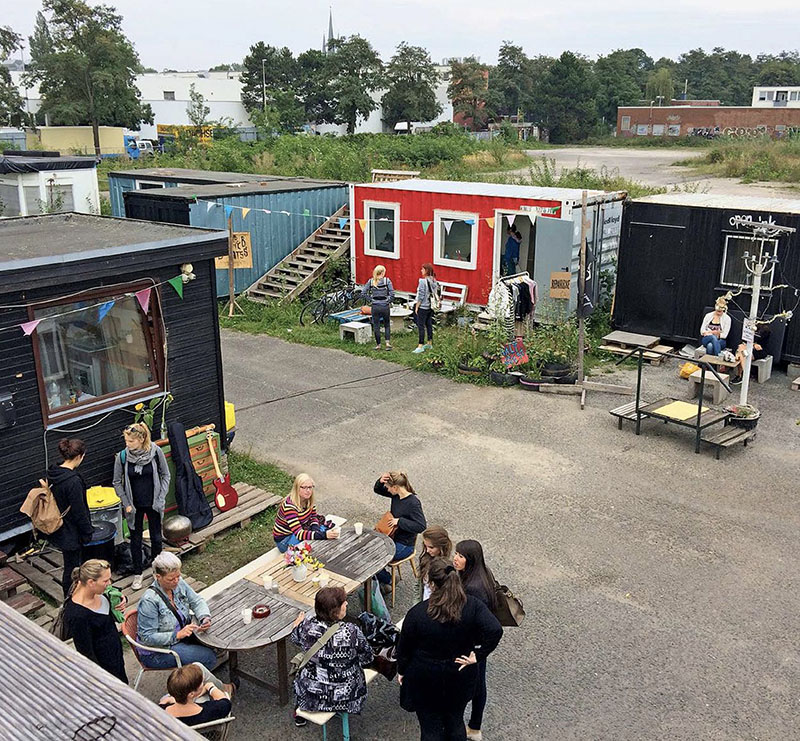How commoning practices foster inclusivity
Downloads
DOI:
https://doi.org/10.7480/rius.6.105Keywords:
urban commons, Inclusive Urbanism LAB, PLATZprojekt, citizen participation, spatial practiceAbstract
The article addresses the concept of urban commons, specifically the ways in which it can contribute to inclusive urbanism. We consider how communities appropriate urban spaces, how commons mediate participation in urban development as well as the role of the physical configuration in fostering inclusiveness. The “PLATZprojekt” in Hanover, Germany, is taken as a case study.
A container village of about 3,000 m2, the PLATZprojekt is understood as an experiment in offering people a self-organized space, one they can actively shape, a space to implement their ideas and to provoke discussion about their city. Initiated by a group of young skateboarders, it was funded by the BBSR[1]. Situated on a vacant lot in an industrial zone relatively close to the inner city, the PLATZprojekt seeks to provide space for projects and ideas that cannot be realised within the gentrified neighbourhoods of dense and commodified European metropolises.
We analyse the PLATZprojekt as a permanent “commoning process” that encompasses different levels of accessibility and represents a positive example of inclusive urbanism while at the same time revealing various limitations.
[1] Federal Institute for Research on Building, Urban Affairs and Spatial Development
How to Cite
Published
Issue
Section
License
Copyright (c) 2020 Julia Köpper, Agnes Katharina Müller

This work is licensed under a Creative Commons Attribution 4.0 International License.
References
Akkar, M. (2005). Questioning ‘inclusivity’ of public spaces in post-industrial cities: The case of Haymarket Bus Station, Newcastle upon Tyne. METU Journal of Faculty of Architecture 22(2), 1-24.
Avermaete, T. (2018). Constructing the commons. Arch+232, 32-43.
BBSR. (2016). Jugend.Stadt.Labor – Wie junge Menschen Stadt gestalten. Bonn.
Cambridge Dictionary: https://dictionary.cambridge.org/de/worterbuch/englisch/inclusiveness (last opened 17th may 2019)
Harvey, D. (2008). The right to the city. New Left Review, 53, 23–40. https://newleftreview.org/issues/II53/articles/david-harvey-the-right-to-the-city
Kip, M., Bieniok, M., Dellenbaugh, M., Müller, A.K., & Schwegmann, M., (2015). Seizing the (every) day: Welcome to the urban commons! In M. Dellenbaugh, M. Bieniok, M. Kip, A.K. Müller & M. Schwegmann, Urban commons: Moving beyond state and market. Birkhäuser.
Ostrom, E. (2011). Governing the commons: The evolution of institutions for collective action. Cambridge University Press.
Pelger, D., Kaspar, A., & Stollmann, J. (2016). Spatial commons. Urban open space as a resource. Universitätsverlag der TU Berlin.
Senatsverwaltung für Stadtentwicklung und Wohnen, Berlin. (n.d.). Leitlinien Bürger*innenbeteiligung an der Stadtentwicklung. https://leitlinien-beteiligung.berlin.de/
Stren, R. E. (2001, February). Thinking about urban inclusiveness. UN-Habitat. http://mirror.unhabitat.org/downloads/docs/2115_2461_inclusive_cities_stren_paper.doc
Stravides, S., & Heyden, M. (2016). City as commons. Berlin Journals – On the History and Present State of the City 4, 14-29.




